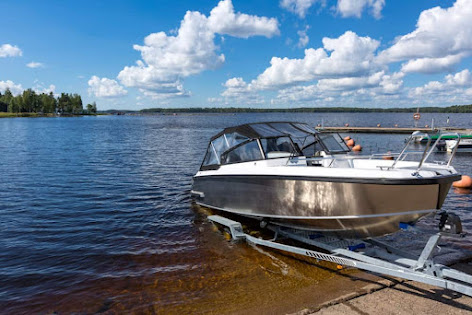Choosing a Trailer Winch: Beginner’s Guide
Trailer winches allow you to pull your boat onto the trailer
while it is on an inclined launch ramp. Winches mount to a custom winch mount
on the trailer tongue, bow stop bracket, or trailer hitch ball using an adapter
plate. The reel or pulley holds a cable, rope, or strap 20-50 feet long, and
has a clip at the bitter end. By attaching the clamp to the bow eye of the boat,
the winch operator can either slide the boat onto the trailer or allow the boat
to slide backwards into the water at a controlled rate. We'll walk you through
common considerations to find the one that suits you best.
- Manual winches for trailer
- The environment of your boat
- Winch weight capabilities
- Single-speed or two-speed levers
- Winch straps
- Tips on trailer safety
Manual Winches for Trailer
Manual winches double your strength, allowing you to pull a
relatively heavy boat against gravity and friction. They also have a ratchet to
secure the boat at any point on the trailer so it doesn't slide back into the
water, allowing the average person to retrieve a boat that weighs more than a
ton using a crank about a foot long and simple gears. Larger models feature a
lower gear ratio for greater power acceleration and two speeds for more power.
Your Boat Environment
Do you use your boat in a freshwater or saltwater lake? Is
the winch galvanized, zinc-coated, powder-coated, or aluminum? Look at how many
hours of salt water exposure the crane is rated to survive.
Winch Weight Capabilities
Winches are rated by their weight capacity, not by boat
length. Choose a trailer winch to suit the weight of your boat, motor, and
equipment. Heavier and longer boats require stronger winches and longer cables.
The general rule is to choose a winch with a capacity that
is at least 3/4 of the total weight of the boat, motor, fuel and gear. This
rule varies depending on a number of factors regarding your boat and where you
launch.
Do you usually set off on steep inclines? Is your trailer
equipped with wood beds covered with carpet instead of rollers? If this is the
case, the load on the winch will be higher, and you should choose a winch with
a capacity closer to the actual weight of the fully rigged boat. Launching
slopes with gentle slopes, or trailers equipped with rollers results in less
drag, so you may choose a smaller winch. However, since the difference in price
between winch sizes is so small, you can choose a larger winch for about the
same cost. We also recommend using Glyde Sliks, EZ Slides, or similar
anti-friction pads on your trailer beds, which help with boat sliding.
Most trailers have a standard winch assembly bolt style, so
upgrading to a stronger trailer winch is easy if your current winch isn't suitable.
Single Speed Winch or Double Speed Winch
How much rolling resistance is there when your boat is
towed? For light boats such as inflatable dinghies and pontoons, a hand winch
with a 3:1, 4:1 or 5:1 gear ratio may be all you need. For heavy-duty work, we
recommend two-speed levers. Fulton's higher-capacity model of the F2 manual
winch gives you fast speed, with a 5:1 gear ratio for quick pulling, and a
lower second speed, with a 16.2:1 ratio, for increased mechanical advantage. A
5-to-1 ratio means you turn the handle five times to make the drum turn once.
Winch Straps
Small hand winches designed for lighter boats generally use polypropylene rope or nylon crampons. Polyester straps are also a great choice for their high weight carrying and the fact that they won't scratch the front of your boat.
.jpg)
Trailer Winch Safety Tips
Trailer winches are not hitching devices. To prevent
mishaps, use a bow, fence, and custom tie-downs to secure your boat to the
trailer. For bigger boats, add a safety chain to the bow eye.
Make sure you have a secure base and proper leverage when
using hand winches. Slips and falls by winch operators and injuries caused by
winch handles snapping back are common accidents at a boat ramp.
To avoid chafing the winch line, make sure it does not rub
against any sharp edges on the winch rack or trailer. If any spots appear
frayed or frayed, replace the winch line immediately with a new rope, harness
or cable of the appropriate type, size and strength. Cable life can be extended
by lubricating it frequently with a wire rope lubricant so that the cable
strands slide against each other with less friction. Lubricating your winch
cable will also reduce the number of snags and wear and tear on the cable.
Related Articles:
.jpg)



Comments
Post a Comment